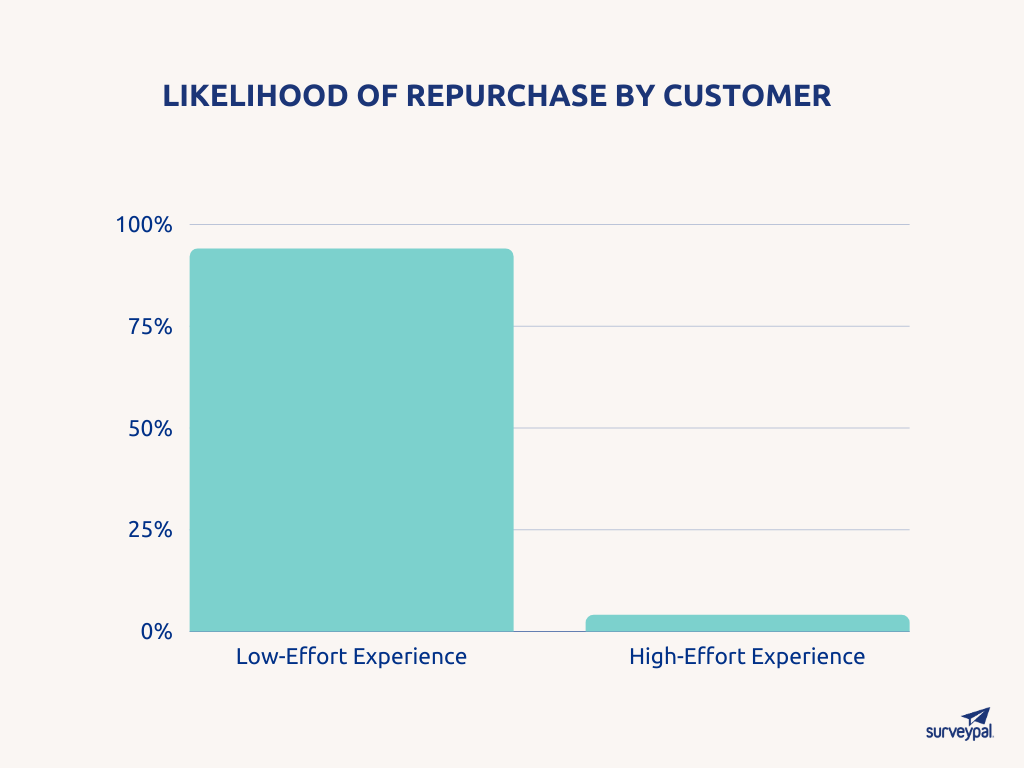Even if you’ve been living in a cave, you must’ve probably had to interact with a brand, whether to make an inquiry, a purchase, or lodge a complaint. Subconsciously or not, you may have held certain expectations of convenience in your interaction with them.
If you think you’re alone in this sentiment, think again. Customer expectation has clocked new heights in what has been the new normal in the world of business — and why not?
In a highly saturated and ultra-competitive business environment, customers should expect convenience and ease in their interaction as a minimum threshold for businesses deserving of their loyalty.
Customers now hold the aces, as the abundance of high-quality options means they can easily deflect to a competitor in the face of labored interaction. As such, customer convenience — making it as easy as possible for customers to do business with you — across marketing, sales, and after-sales service, is well worth the elbow grease.
This stat released by the CEB claims 94% of customers that went through an effortless experience will repurchase, as against a mere 4% who exerted high effort levels.

For customer support, customer convenience can involve different approaches, such as omnichannel customer service (providing multiple channels for interaction via phone, email, online chat, and social media), knowledge base articles (for customers to find product information on the company website easily), and streamlining processes like ordering & returns.
A customer may stop doing business with a brand due to a perception that it requires too much effort to continue using its products/services. For instance, repeatedly contacting customer service to resolve an issue or an excessively complicated process of returning a product.
The Customer Effort Score (CES) is a metric used to measure and evaluate satisfaction levels based on how much effort customers perceive they have to put in to interact with a company. This score gives insight into support performance.
Thus, a high Customer Effort Score indicates a high risk of losing customers to competitors. It can also bring system/process inefficiency to the surface for easy troubleshooting, saving you otherwise-incurred costs and reduced profitability. CES also identifies areas to funnel resources into for a better customer experience.
What is Customer Effort?
Customer effort is the level of difficulty and complexity (in terms of time, energy, and resources) customers experience during their interaction with your brand. The lower the effort, the better the experience.
At its core, it’s closely linked to satisfaction, retention and loyalty. When customers complete tasks quickly and easily, they’re more likely to engage with your product, repurchase, and refer other customers.
Reducing customer effort requires carefully analyzing every touchpoint where customers interact with your product or service—from initial onboarding all the way through ongoing support and maintenance—to identify areas where friction can be reduced.
What is Customer Effort Score?
Customer Effort Score (CES) is a metric used to measure the amount of effort customers must expend to complete their interactions with a company or product.
A crucial and reliable indicator of customer experience, it pinpoints areas where customers are having trouble and provides feedback for support teams to make improvements accordingly, whether by streamlining processes or providing additional training for employees who interact directly with customers.
The CES sprung into existence in 2010 after CEB Global (Now Gartner) found customers with high-effort interactions the least loyal to brands. With a whopping 96% of high-effort customers and a miserly 9% of low-effort customers reporting disloyalty, it emerged that the key to winning customers’ hearts was not necessarily packing the wow factor but creating a seamless and frictionless experience.
How to Calculate Customer Effort Score?
There are several ways to evaluate your Customer Effort Score. The most common methods include using a survey, automated feedback capture, and direct customer interaction. That said, of all three, the survey is the most widely adopted. Here, we delve into the different types of surveys and their upsides for customer support teams:
The Likert scale
A popular method for measuring customer effort score (CES), it includes multiple-choice questions designed to gauge how satisfied an individual is with their experience.
Questions generally ask about the overall customer service and support, as well as specific details about each interaction or encounter. Respondents then rate their level of satisfaction by selecting a number from a scale called the Likert scale. This scale presents an index of numbers that measure the amount of effort exerted to complete interaction.
- 1-7
In the 1-7 scale, the value ascribed to the range of numbers depends on the question. Generally speaking, the questions ask respondents to give their assessment of the amount of effort it took to do something. 1-3 represents low effort (positive response), and 5-7 would mean high effort (negative response)
On the flip side, if the question asks to rate their level of ease, you would expect 1-3 to represent a low value (negative response) and 5-7 to represent high value (positive response that indicates a quality customer experience)
- 1-5
This scale comes with a range of five levels of difficulty namely: Very Difficult – Difficult – Neither – Easy – Very Easy. The order is reversible.
Emoticons
Emoticon faces provide an easy, intuitive, and visual representation of the customer’s experience. By simply showing customers four emoticon faces ranging from very happy, neutral and unhappy, or dissatisfied, you can quickly gauge their experience during their interaction with your product or service.
Mode of Calculation
After responses are collected, the Customer Effort Score is calculated by averaging out all of the individual responses to your CES survey question.
In simple terms, take out the sum of the response scores, then divide this figure by the total number of responses:
(Sum of response scores) ÷ (Number of responses) = CES score.
CES scores for most companies tend to stay between 5 — 5.5. A score that is higher than 6 is generally said to be more than average.
Customer Effort Score Questions
With there being no universally accepted method, here’re a few questions to solicit responses needed to calculate your customer effort score:
- How much effort did you put into solving your issue?
- How knowledgeable was your assigned customer service rep?
- How fast were you able to solve your problem?
- Overall, how easy was it for you to solve your problem with (input name of assigned customer service rep)?
- How easy was it for you to (include the form of interaction undertaken with your company)?
- (Insert name of company) made it easy for me to solve my issue. To what extent do you disagree or agree with this statement?
When Should You Use the CES?
Generally, the customer effort score is best used when measuring the amount of effort customers put in to complete a task or interaction. It could range anything from calling customer service, to completing a purchase or signing up for accounts.
Overall, here’re a few notable touchpoints in the customer journey where a CES should come in handy:
Immediately after purchase or subscription
Once a client interacts with your business, sending out a CES survey to gauge the level of effort required or the extent of ease gives you a better perspective into how you’re faring in CX.
Since these experiences are specially curated for customers, the immediacy helps ensure customers at giving feedback at a time when the experience is fresh in their minds, increasing the likelihood of honesty.
As an example, you can strategically place a survey at the final page of your website for members (so they land on it immediately after completing a subscription renewal), prodding them to rate how easy the process was for them.
Immediately after a customer service interaction
Bombarding customers with CES surveys hardly puts any ease into their experience (which defeats the core essence of the CES). Companies can be more strategic and send in surveys right after certain touchpoints of customer interaction.
You can set automation triggers to send this CES survey as an email immediately after jumping off a support call with them or resolving an email support ticket, nudging them to give a response rating to your statement or question about the interaction they just completed with you.
All in all, these responses should be shared with customers who may have needed to contact support for a particular issue immediately after the said issue has been resolved. That way, support can find out how easy or difficult it was for them to get help.
After releasing a new product feature
An overlapping tool for both customer success and product development teams, using CES after a new feature is released can give companies instant feedback on how their customers are interacting with a new feature to know if changes are to be made.
It helps to quickly identify areas of improvement in the UI for a better experience. It also allows companies to ensure their customers are getting the most value out of the feature, which can lead to a higher feature adoption, loyalty and satisfaction levels.
What is a Good Customer Effort Score?
Given the absence of a widely accepted scale, the closest you can come to a good customer effort score is to glean conclusions about your CES from how high or low the number tilts to the scale.
As such, if a number tilts more to the higher end of the scale, then you have a positive experience. The opposite may suggest you need to look into your customer experience.
A good way to benchmark your current CES will be to compare it to your score 6 months or 1-year ago. That way, you’re able to accurately monitor how easy or difficult your customers’ experience is.
The Benefits of Measuring the CES
With deeper understanding of hidden customer pain points and valuable insights into how to improve the overall customer experience already in the bag, here are some more far-reaching benefits of measuring CES:
CES is a reliable indicator of future repurchase
As this Customer Contact Council study observes, one of the perks of measuring CES is the utility of the available data when it comes to predicting future purchasing behavior. In the study, 94% of customers reporting low effort indicated an intention to re-purchase, while 88% admitted to a high chance of increased spending.
Customers who experience high levels of effort typically give lower ratings, indicating that they are less likely to repurchase from the same business in the future. In contrast, customers who experience low levels of effort are more likely to give higher ratings and are more likely to repurchase from the same business in the future.
Thusly, companies that can consistently provide low-effort customer experiences will likely experience a higher rate of customer loyalty and repurchase. CES is also a valuable tool for businesses looking to drill down on what types of customer service interactions are providing the greatest satisfaction to improve CX and increase repurchasing rates.
CES is an indicator of referral likelihood
If it’s good enough for you, then it’s probably good enough for friends and family. This common wisdom is the driving force being the CES’s prediction of referral likelihood. In the earlier-cited report, 81% of customers reporting much effort indicated that they will spread the word about their negative experience to others.
Measuring consumer sentiment by taking into account factors such as customer satisfaction, brand loyalty, and propensity to purchase, CES can help launch an inquiry into the current state of customer relationships with a business or product.
Utilizing CES, brands measure customer sentiment and create campaigns that resonate. This allows for more targeted messaging and ensures that brands are reaching the right people at the right time and in the most effective way.
As a result, businesses are able to increase customer referrals by providing better experiences for existing customers.
It is actionable
Insights gotten from the Customer Effort Scpre are highly actionable as they accurately represent the state of customer happiness at the time the survey was filled out. That way, you can see areas customers interact with, for instance, how easy it is to book support tickets or call support.
Pinpoints areas for improvement
CES surveys are short and easy to navigate, thereby increasing the likelihood of high completion. However, the key to weaponizing data from these surveys to is to break it down into smaller, more manageable chunks.
If you see that customers are having difficulty navigating through a particular step of a customer journey, the next port of call will be to focus efforts and resources towards improving that particular experience.
And so, by looking at customer effort scores over time, you can track changes in overall customer satisfaction and identify patterns and trends between different levels of customer effort, allowing you to understand which areas need your immediate attention while eliminating guesswork.
The Limitations of CES

While the benefits CES portend for customer service teams are well-documented, it’s not totally covered in glory, as there are still certain insufficiencies we’ve outlined below:
Lack of data on other variables
One of the main drawbacks of using a Customer Effort Score is that it may not provide the most accurate assessment of customer experience since it only focuses on how easy or difficult it was for customers to have their problem solved.
Besides a lack of room for fine-grained analysis or detailed feedback, it also doesn’t account for more consequential variables like customer satisfaction or loyalty, and how these are influenced by your competition, pricing, and products.
No way to measure improvements
Regrettably, the CES also doesn’t offer a way to measure improvement over time, making it difficult to identify areas needing attention and adjust accordingly.
No customer segmentation
Further, it’s worth pointing out that the CES surveys hardly capture a broad net of customers to allow for segmentation.
Here’s what we mean: while CES is a strong indicator of purchasing/re-purchasing intent, it only applies to customers who may have initiated a specific interaction with the support team or exercised a self-service option — not knowing where they are in the buyer’s journey makes CES not rewarding enough for a supposedly transactional survey.
Time-sensitive
The phrase, “strike while the iron is hot” comes to mind. There is a small sliver of time between the customer’s completion of their interaction and life getting in the way with other things, during which you must send in your request to access the CES. Failure can leave you prone to customers who can put up inaccurate responses or a no-show.
Requires follow-ups for more context
In summary, while the Customer Effort Score offers a quick and easy way to signify an exertion of high effort in the interaction, but it fails to state the why, thereby making it not the most comprehensive tool available. A follow-up, however, can provide the finer details, allowing organizations to make better-informed decisions.
With these in mind, companies should consider supplementing the Customer Effort Score with additional data and metrics to gain a deeper understanding of customer experience.
How does the CES Correlate with Customer Satisfaction (CSAT) and Net Promoter® Score (NPS)?
While the CES measure is focused on measuring the level of ease in customer interaction — and, as a result, customer experience, CSAT measures customer satisfaction with their experience of a product or service, and Net Promoter Score (NPS) measures customer loyalty — how likely a customer is to recommend a company or service to others.
All three metrics are chock full of hidden insights into the customer experience, with each providing unique data to help companies improve their customer service.
The consequential link between level of customer effort exerted and levels of customer satisfaction means companies are better off pairing the CES with other satisfaction metrics like the NPS to get a 360° view of customer happiness and troubleshoot poor experiences (indicating high effort).
How to Improve the Customer Effort Score
To get the most out of your CES on your way to leveraging insights from responses for improvements that yield even better CES, there’re several steps you can take:
Open-ended questions:
Rather than box yourself into a corner by limiting responses to a mere numeral value, ask more open-ended questions that prove more free-form, detailed responses on what worked in the interaction and what failed.
A quick sorting through these texts (preferably using the text analysis method) may reveal commonalities, trends, and persisting problems that could be fixed.
Create a customer journey map:
Creating a customer journey map helps to identify areas in your customer’s experience where you can improve their satisfaction and reduce effort. By understanding each step of the customer’s experience, you can prioritize improvements and measure their impact on customer effort.
Establish a baseline score:
Setting a baseline score for Customer Effort Score gives you an indication of the current level of customer effort. This helps to provide context when evaluating changes or trends in your data over time.
Analyze your responses:
Reviewing responses helps identify the areas of customer experience that are driving higher or lower levels of effort. You’re also better served using automation tools, rather than manually sorting through the sea of responses.
Wrapping Up
Companies can be forgiven for trying too hard at times, reaching staggering levels of complexity, without knowing that where the sweet spot lies in is shockingly simple.
Of course, to suggest that customer loyalty is unresponsive to going the extra mile (e.g., loyalty bonus, offering refunds) would be starkly misleading, but the available data points to mere marginal gains — marginal enough to stick with the simple stuff. In other words, dust down and optimize interactions for ease.
Rather than tasking reps with creating fireworks in your customer experience, which — by the way — could backfire in customer confusion, wasted time and resources, or costly misgivings, why not take your team’s foot off the gas? It’s largely liberating (just ask your support team!) and provides a far better workbench to scale up the customer experience.
A business-critical metric, the Customer Effort Score is a strong indicator of repurchase and referral likelihood. As such, empowering frontline customer support staff to deliver a low-effort experience and improve customer effort scores should be top of mind for any company looking to ensure a pipeline of loyal, repeat customers.
Did you like the post?
You might also like:
Hot and trending:

Surveypal
Everything you need to lead and improve your customer experience. Learn more at surveypal.com, or







